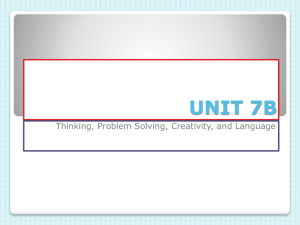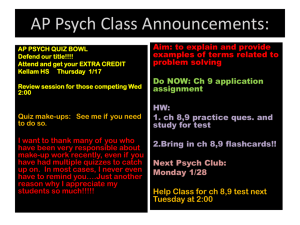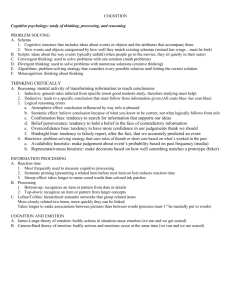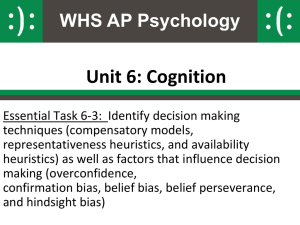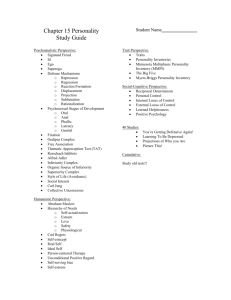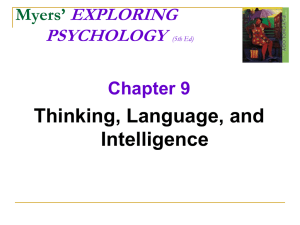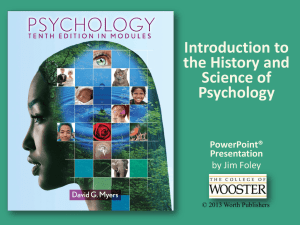Critical Thinking - Deerfield High School
advertisement
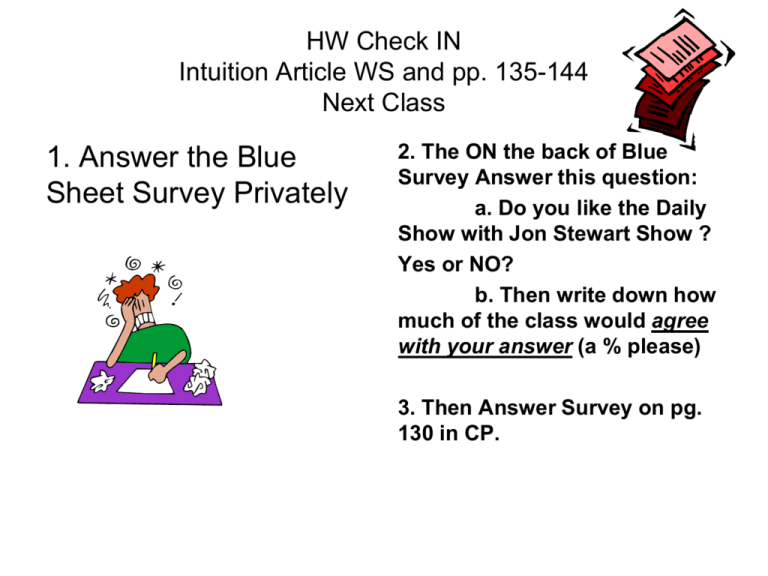
HW Check IN Intuition Article WS and pp. 135-144 Next Class 1. Answer the Blue Sheet Survey Privately 2. The ON the back of Blue Survey Answer this question: a. Do you like the Daily Show with Jon Stewart Show ? Yes or NO? b. Then write down how much of the class would agree with your answer (a % please) 3. Then Answer Survey on pg. 130 in CP. Intuition and Common Sense Video Analysis: Moneyball • Take notes over the key points the 2 scenes address. • With a partner discuss how these two scenes connect to the Articles you read on Intuition. The Limits of Intuition and Common Sense • We are not passive recipients of information, we ACTIVELY INTERPRET and construct our social perceptions to fit our preconceived notions of how the world works and operates. – People are basically LAZY THINKERS; willing to infer and judge by using mental “shortcuts” and otherwise not thinking too much about things. • People make sense of their world by fitting it to their preconceived notions • Two mind system: – System one = intuitive, rooted in personal experience, imbued with emotion and interested in here-and-now situations. Unconscious mind • Intuition = rapid thought that happens outside of conscious awareness. Presumptions, perceptions, and beliefs that are more or less instantaneous – System two = logic and deduction, analyzes the odds and selects the most rational decision. Conscious mind. Handout 1-2 (Blue Survey) : Predicting Research Outcomes • Read the research results and respond to the questions. Also, document whether you are surprised by the finding. • How many of you were surprised by the finding? How many of you checked “not surprising”? • There’s a problem… for half of you were given a finding that is opposite what the other half received. • We have a tendency to exaggerate our ability to have foreseen how something would turn out AFTER learning the outcome. Hindsight Bias • Tendency to believe that one would • have foreseen it after the results are shown. – “Seems like common sense.” – “The answer was right there and look how obvious it was.” • • – “I knew it all along • EX: Research on low self-esteem or high selfesteem and susceptibility to flattery. Perception that psychological research findings merely verify our common-sense understanding EX: School Shootings EX: Several weeks after a political election, voters often exaggerate their ability to have predicted the election outcome. EX: Natural Disasters • After Hurricane Katrina caused massive flooding in New Orleans in 2005, many believed that public officials should have anticipated the problem. After all, studies of the levee’s vulnerability had been conducted, demographics indicated that many residents did not own cars and were too poor to afford transportation and lodging out of town, and meteorologists’ assessment of the storm’s severity predicted the need to put security and relief supplies in place. Opinion Exercise • “I like the Daily Show with Jon Stewart” Yes? No? • Estimate the % of people in class that you believe share your opinion. • How many selected yes? • How many selected no? • How many overestimated the number of people in agreement with them? False Consensus Effect • We believe others agree with us more than they do. • We spend most of our time with a biased sample of people, mostly those who share our attitudes and habits. • EX: Jon Stewart Question • EX: Conservatives think more people support conservative views than will people who are liberals. • EX: You mistakenly assume that everyone around you enjoys listening to country music like you do. Confirmation Bias • We seek out or notice evidence that will verify our ideas more eagerly than we seek evidence that might refute them – EX: Stereotypes we hold – EX: Business managers are more likely to follow the successful careers of those they once hired than to track the achievements of those they rejected. – EX: Reading newspaper columnist that agree with our point of view and avoiding those who don’t. Belief Perseverance • Tendency to cling to our beliefs in the face of contrary evidence. • • • EX: Thomas believes that rich people are stuck up. His friend, Elaine, introduces him to several rich people who are not at all stuck up. Thomas still believes rich people are stuck up. EX: Coaches continue to believe that hot hands in b-ball exist – Scoring streaks are often interpreted as meaningful. A player has a better chance of making a shot after just making two or three shots than after just missing two or three shots. – Analysis of thousands of shot sequences finds that a player’s overall average is the best predictor of what is likely to happen next. – Misinterpreting streaks, not misperceiving them. EX: Once people have explained to themselves why they believe that women or men are naturally superior or that a child is gifted or learning disabled, they tend to ignore the evidence that undermines that belief. Prejudice persists. Illusory Correlations • Both belief perseverance and confirmation bias are results of people making illusory correlations (perceived correlation that does not really exist) – when we believe there is a relationship between two things, we are likely to notice and recall instance that confirm our belief • EX Hot hands in b-ball • EX: “Of course it rained. That is because I just washed my car!” • EX: As soon as you switch into a grocery line that appears to move faster, the new line slows down and the old line speeds up. • EX: The gambler believes he can control the dice by how he throws them – a hard roll for a big number and a soft roll for a low number Handout 9-5 (pg 130 in CP) • 1. 2. 3. 4. 5. 6. 7. 8. 9. 10. 11. 12. 13. 14. 15. Fill out survey Deaths per 100,000 All accidents (37.7) vs. strokes (51.1) Suicide (10.9) vs. blood poisoning (11.2) Homicide (5.9) vs. diabetes (24.5) Motor vehicle accidents (15.3) vs. colorectal cancer (17.8) Drowning (1.3) vs. leukemia (7.1) Largest Population Morocco (34 million) vs. Saudi Arabia (28 million) Myanmar (47 million) vs. Australia (21 million) Vietnam (86 million) vs. South Africa (48 million) Sri Lanka (20 million) vs. Libya (6 million) Tanzania (38 million) vs. Iraq (28 million) Highest Crime Rate Chicago (15.6) vs. Kansas City (26.1) Las Vegas (11.3) vs. Stockton (14.6) Miami (13.9) vs. Phoenix (15.0) Honolulu (1.7) vs. Raleigh (6.0) New York (6.6) vs. Aurora (9.5) Handout 9-5 • Quiet cause of death is actually more prevalent – People perceived the more publicized and easily pictured cause to be more common=Representativeness Heuristic • Less familiar countries have greater populations but respondents judge those that are familiar to them to be more populous • Larger or more familiar cities are judged to have a higher crime rate. • Overconfidence – compare the percentage of questions you answered correctly with your average confidence level. How many were more confident than correct? Representative Heuristic • Judge a person, object, or event by how similar it is to what you imagine to be a typical representative of a category. – We think that people who exhibit certain characteristics will exhibit other, related characteristics. We think that “like goes with like” • EX: If I meet someone with a laid back attitude and long hair, I might assume they are Californian, whereas someone who is very polite but rigid may be assumed to be English. • EX: People who were told that Linda majored in philosophy and was a social activist. Then they ranked the probability of statements about Linda – Linda is a bank teller – Linda is a bank teller and a feminis • 80% of people rated the statement “Linda is a bank teller and a feminist” as more likely than “Linda is a bank teller” • This contradicts the fact that the probability of x is greater than the probability of x and y cooccurring (when x and y are independent events) Overconfidence Effect • Tendency to overestimate the accuracy of one’s beliefs and judgments. A result of the selfserving bias. • • • • EX: When American students start college, only 2% say there is a very good chance they will drop out permanently or temporarily. EX: Students are overconfident about how quickly they can do assignments and write papers. EX: Following the 1986 Challenger explosion, Nobel prizewinning physicist Richard Feynman asked NASA officials what risk of failure each mission carried. NASA engineers said about 1 in 100 flights was likely to experience a catastrophe. NASA managers put the risk closer to 1 in 100,000. Some experts speculate that managers’ overconfidence may have contributed to the Columbia disaster in February 2003. EX: Planners often exhibit overconfidence in estimating how quickly and inexpensively they can do a project. – Millennium Park was supposed to open in 2000 at a cost of $150 million… It opened four years late at more than triple that cost. Overconfidence among Experts • • • • • • • • “There is no reason for anyone to have a computer in their home.” (Ken Olson, president of Digital Equipment Company, 1977) “Heavierthanair flying machines are impossible.” (Lord Kelvin, British mathematician, physicist, and president of the British Royal Society, 1895) “Reagan doesn’t have the presidential look.” (United Artists executive when asked whether Ronald Reagan should be offered the starring role in the movie The Best Man, 1964) “A severe depression like that of 1920–1921 is outside the range of probability.” (Harvard Economic Society, Weekly Letter, November 16, 1929) “Impossible!” (Jimmy “The Greek” Snyder when asked whether Cassius Clay could last six rounds in his upcoming bout with heavyweight champion Sonny Liston, 1964) “We know on the authority of Moses, that longer ago than six thousand years, the world did not exist.” (Martin Luther [1483–1546], German leader of the Protestant Reformation) “Man will never reach the moon, regardless of all future scientific advances.” (Lee DeForest, inventor of the vacuum tube, 1957) “Nuclear powered vacuum cleaners will probably be a reality within 10 years.” (Alex Lewyt, manufactures of vacuum cleaners, 1955) Vivid Cases / Availability Heuristic • People judge the frequency of an event by how easily it is brought to mind. • • • • • EX: Fear of airplane crashes – US travelers during the 1980s were 26 times more likely to die in a car crash than on a commercial flight. EX: Casinos entice us to gamble by signaling even small wins with bells and lights – making them vividly memorable – while keeping big losses invisible. EX: Subjects guess that more people die from guns than asthma, cancer than stroke, murder than floods. Yet, in each case they were wrong. EX: Changes from a wrong to right answer on a test outnumbered changes from right to wrong 2-to-1. Frustration with and memory of correct answers being changed to wrong answers causes people to think answer-changing is bad EX: The one person who won $197 million in the lottery is remembered more readily than the 328 million losing tickets that build the jackpot Availability Heuristic • • • The media sometimes leads us to have a distorted view of the frequency of certain events by overexposing us to some events and underexposing us to others? The FBI classifies crime in the United States into two categories: – Violent crimes, such as murder, rape, robbery, and assault, – Property crimes, such as burglary, larceny, or car theft. • What percentage of crimes would you estimate are violent rather than property crimes? • What percentage of accused felons plead insanity? What percentage are acquitted? • What percentage of convictions for felony crimes are obtained through trial instead of plea bargaining? – In 2006, there were 417,745 violent crimes and 9,983,568 property crimes. Violent crimes were 12.4 percent of the total of all crimes. – Less than 1 percent of all accused felons plead insanity and only a quarter of those are ultimately acquitted. – Less than 10 percent of convictions for felony crimes are obtained through a trial; more than 90 percent result from plea bargaining. However, aided by the news media’s reporting, we tend to overestimate the number of violent crimes, pleas of insanity, and trials, because they are more available to memory. • Discovering Psychology: Judgment and Decision Making • http://www.learner.org/vod/vod_window.ht ml?pid=1524 Handout 1-5 • Fill out survey • By a show of hands, whose estimate was greater than 1500 miles? Whose estimate was greater than 30 million people? • The Mississippi River is actually 2348 miles and the population of Argentina is more than 40 million. Anchoring and Adjustment Heuristic / Framing • Make judgments by starting with an initial estimate and then adjust it to yield the final answer. When people are presented with an answer to a question, they use that answer as a reference point. How an issue is framed can significantly affect decisions and judgments • EX: Participants were shown a number, either 10 or 65. They were then asked to estimate the proportion of African nations in the UN. People who saw a 10 gave an average estimate of 25%. Those who saw a 65 gave an average estimate of 45% • EX: What is the best way to market ground beef- As 25% fat or 75% lean? • EX: A surgeon tells someone that 10% of people die, while another surgeon tells someone that 90% survive. Info is same, but effect is not. The risk seems greater to those who hear that 10% will die. • EX: offer regular prices as sale prices. Anchoring Heuristic causes problems when people take surveys • • Respondents may be totally ignorant of an issue and often do not want to admit it. – In one famous study, a third of the people surveyed offered an opinion about a nonexistent “Public Affairs Act.” Many respondents tell pollsters only what they think the dominant media want to hear. – Their tendency to give acceptable rather than honest responses is also evident in how the gender and race of the interviewer influence results. When interviewed by Whites, 62 percent of White respondents agreed that “The problems faced by Blacks were brought on by Blacks themselves.” When interviewed by Blacks, only 46 percent agreed. When interviewed by a man, 64 percent of women agreed that “abortion is a private matter that should be left to the woman to decide without government interference.” When interviewed by a woman, 84 percent of women respondents agreed. Respondents may be ignorant of the numbers or words used – A survey of 1255 adults by New York’s American Museum of Natural History and Louis Harris found: • 77 percent were interested in plants and trees but only 39 percent were interested in botany. • A total of 48 percent were interested in fossils but only 39 percent were interested in paleontology. • Of the total sample, only 42 percent were interested in rocks and minerals, but 53 percent were interested in geology. Problem Solving Strategies 1. 2. 3. 4. 5. Changing the Representation of the Problem = many problems can be represented in a variety of ways, such as verbally, mathematically, or spatially. When you fail to make progress with your initial representation of a problem, changing your representation. Insight = sudden and often novel realization of the solution to a problem. Trial and Error = successive elimination of incorrect solutions until the correct one in found. Works best when choices are limited. Algorithms = methodical (step-by-step), logical rule or procedure that guarantees solving a particular problem. Heuristics = rule of thumb that help in simplifying and solving problems, although they do not guarantee a correct solution a. Availability Heuristic b. Representative Heuristic c. Anchoring Heuristic d. Hill Climbing = moving continually closer to our final goal without ever digressing or going backward. e. Means-end Analysis = identifying differences that exist between the current state and the goal state and making changes that will reduce these differences. • Setting subgoals = breaking a problem into smaller, more manageable pieces, each of which is easier to solve than the problem as a whole. f. Working Backward = the search for a solution begins at the goal and works backward toward the “givens.” g. Searching for analogies – if you can spot an analogy between problems, you may be able to use the solution to a previous problem to solve a current one. Changing the Representation of the Problem 1. Buddhist Monk Problem – visualization 2. Husbands and Wives Problem – matrix 3. Six Match Problem How would you arrange six matches to form four equilateral triangles? Insight 1. EX: Jokes and riddles 2. EX: Aha! Experiences A. Rebuses B. Chain-Link Problem C. Wealthy Desert Dweller D. Story of the Hunter E. Nail Problem Jokes and Riddles The maker doesn’t want it, the buyer doesn’t use it, and the use doesn’t see it. What is it? Can you translate the following into a sentence? 100204180 A coffin I ought naught to owe for I ate nothing. What number is next in this series: 10, 4, 3, 11, 15 …? A. 14 B. 1 C. 17 D. 12 14. When spelled out, each number in the series is longer than the previous number by one letter. What is so unusual about the sentence? “Jackdaws love my big sphinx of quartz.” What occurs in every minute, twice in every moment, yet never in a thousand years? The letter M How can you physically stand behind your father while he is standing behind you? A man left home one morning. He turned right and ran straight ahead. Then he turned left. After awhile, he turned left again, running faster then ever. Then he turned left once more and decided to go home. In the distance he could see two masked men waiting for him. Who were they? Stand back to back The umpire and the other team’s catcher It’s the shortest sentence in the English language that includes every letter of the alphabet Something extraordinarily unusual happened on the 6 th of May, 1978, at 12:34 p.m. What was it? At that moment, the time and day could be written as 12:34, 5/6/78 Can you translate the following? Y Y U R Y Y U B I C U R Y Y 4 M E. Too wise you are. Too wise you be, I see you are, Too wise for me. Setting Subgoals 1. Tower of Hanoi Problem 2. Hobbit and Orcs Problem Working Backward 1. Hobbit and Orcs Problem Problem Solving Obstacles: Fixation and Mental Set • • Fixation – inability to restructure or reorganize problems. Inability to see a problem from a new perspective. Mental Set – the tendency to perceive and to approach problems in certain ways - repeat solutions that have worked in the past. Have a hard time solving the following problems because you have a wellestablished habit of perception or thought. – EX: Two grandmasters played five games of chess. Each won the same number of games and lost the same number of games. There were no draws in any of the games. How could this be so? • Solution: They didn’t play against each other. – EX: A man who wanted a drink walked into a bar. Before he could say a word he was knocked unconscious. Why? • Solution: He walked into an iron bar, not a drinking establishment. Mental Set • • 1. 2. 3. 4. 5. • Need paper and pencil in solving the following problem: – Assume that you’re the engineer of a passenger train. At the first station, 20 passengers get on. At the next station, 5 passengers get off and 15 get on. At the next station, 10 passengers get off and 12 get on. At the next station, 7 get off and 10 get on. At the next station, 20 passengers get off and 5 get on. At the next station, 8 passengers get off and 3 get on. Write down numbers 1 through 5 to answer the following questions: How old is the engineer of the train? How many stations were there? How many passengers are left on the train? Altogether, how many passengers have gotten off the train since the first station? Altogether, how many passengers have gotten onto the train anywhere along its route? We pay attention to only some aspects of information input and ignor wthe rest. Only that information to which we are attuned is available for processing toward a solution. We tend to use the specific strategies that have worked in the past. Functional Fixedness • Our tendency to see the functions of objects as fixed and unchanging. The more you use an object in one way, the harder it is to see new uses for it. • EX: Candle Mounting Problem • Solution: Have to think of using the box for more than it’s normal use. • EX: a person might ransack the house for a screwdriver when a dime would have turned the screw. Using these materials, how would you mount the candle on a bulletin board? Answers to pp. 133-134 in CP Limits To Intuition W.S. • • • • • • • • • • • • • • • • • 1. Hindsight Bias 2. FAE 3. Overconfidence 4. Rep. Heuristic 5. Illusory Correlation 6. Availiability Heuristic 7. Hindsight Bias 8. Anch Heuristic 9. Gamblers Fallacy 10. Sunk Cost 11. Illusory Correlation 12. Framing 13. Overconfidence 14. Hindsight Bias 15. Conf Bias 16. Halo Effect 17. Barnum Effect 18. Anchoring 19. False Con Effect 20. Belief Perserverance 21. Sunk Cost 22. Hindsight Bias Problem Solving Obstacles: Unnecessary Constraints 1. Unnecessary Constraints - specifying all the constraints governing a problem without assuming any Without lifting your pencil or retracing constraints that don’t any line, draw four straight lines that connect all nine dots exist. EX: Nine-Dot Problem

